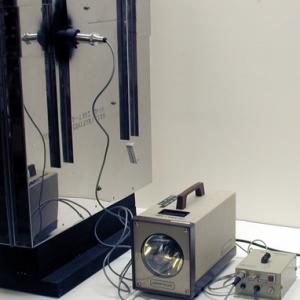College of Liberal Arts & Sciences
7G10.10 - Laser Theory
The large metal demo with the ping-pong balls is an example taken right out of McCliments book, Page 780, Figure 23-34.
Everything should be explained there. Stick the photogate into the hole in the back of the demo pointing towards the black screen on the Plexiglas front. Turn on the strobe. Start the air blowing first - Full blast out of the compressed air line - and then open the gate to let the balls into the stream. There should be a population inversion at the top layer and as the ping-pong balls fall from this level to the next level they should trigger the photocell which will flash the strobe (this is the spontaneous emission). The balls have to be falling at a rate faster than 200 balls per minute for the strobe to work properly. Close the gate that lets the balls into the air stream BEFORE you shut off the air stream.
Note: This is a very NOISY demo so do your explanations before or afterwards.
- David V. Guerra, "The Human Laser", TPT, Vol. 34, #3, Mar. 1996, p. 170.
- David A. Van Baak, "Just How Bright Is A Laser?", TPT, Vol. 33, #8, Nov. 1995, p. 497.
- Claudine Carlton, "Lasers", TPT, Vol. 30, #8, Nov. 1992, p. 486.
- "What's a Laser?", TPT, Vol. 24, #1, Jan, 1986, A Physics Student Newsletter, Vol. I, # 1, Jan. 1986.
- Phillip F. Schewe, "Laser", TPT, Vol. 19, #8, Nov. 1981, p. 534.
- John F. Ready, "Properties and Applications of Lasers", TPT, Vol. 6, #7, Oct. 1968, p. 344.
- D. G. H. Andrews and D. R. Tilley, "A Computer Model of Laser Action in the Teaching of Computational Physics", AJP, Vol. 59, #6, June 1991, p. 536.
- H. -J. Dohner and W. Elsasser, "Analysis of a Four-Level Laser System: Investigations of the Output Power Characteristics of a He-Ne Laser", AJP, Vol. 59, #4, Apr. 1991, p. 327.
- Jianshi Zhou and Gregory A. Fiete, "Rare Earths in a Nutshell", Physics Today, Vol. 73, #1, Jan. 2020, p. 66.
- Richard J. Fitzgerald, "Toward a Solar-Powered Laser", Physics Today, Vol. 69, #4, Apr. 2016, p. 23.
- Richard J. Fitzgerald, "A Diamond Brightness Converter", Physics Today, Vol. 67, #6, June 2014, p. 21.
- William Joyce, "More Light on Ruby Laser’s History", Physics Today, Vol. 63, #5, May 2010, p. 10.
- Donald N. Langenberg, "More Light on Ruby Laser’s History", Physics Today, Vol. 63, #5, May 2010, p. 10.
- Viktor Evtuhov, "More Light on Ruby Laser’s History", Physics Today, Vol. 63, #5, May 2010, p. 10.
- Isaac D. Abella, "More Light on Ruby Laser’s History", Physics Today, Vol. 63, #5, May 2010, p. 10.
- Donald F. Nelson, Robert Collins, and Wolfgang Kaiser, "More Light on Ruby Laser’s History", Physics Today, Vol. 63, #5, May 2010, p. 10.
- Ralph F. Wuerker, "More Light on Ruby Laser’s History", Physics Today, Vol. 63, #5, May 2010, p. 9.
- Jeff Hecht, "More Light on Ruby Laser’s History", Physics Today, Vol. 63, #5, May 2010, p. 8.
- Donald F. Nelson, Robert J. Collins, and Wolfgang Kaiser, "Bell Labs and the Ruby Laser", Physics Today, Vol. 63, #1, Jan. 2010, p. 40.
- William E. Carter, Ramesh L. Shrestha, and K. Clint Slatton, "Geodetic Laser Scanning", Physics Today, Vol. 60, #12, Dec. 2007, p. 41.
- Mark Wilson, "Researchers Achieve Lasing From a Single Trapped Atom", Physics Today, Vol. 57, #1, Jan. 2004, p. 16.
- C. L. Strong, "The Amateur Scientist: A Carbon Dioxide Laser is Constructed by a High School Student in California", Scientific American, Vol. 225, #3, Sept. 1971, p. 218.
- John H. Moore, Christopher C. Davis, and Michael A. Coplan, "Lasers", Building Scientific Apparatus 2nd Edition, p. 206 - 228.
- Gordon McComb, "He-Ne Colors", Lasers, Ray Guns, & Light Cannons, p. 70 - 71.
- Edward R. McCliment, "Figure 23-24", Physics, p. 780.
- T. D. Rossing and C. J. Chiaverina, "Figure 6.6, Transitions Between Energy Levels in Ruby Laser", Light Science, Physics and Visual Arts, p. 139.
- T. D. Rossing and C. J. Chiaverina," #6.7, Laser Light", Light Science, Physics and Visual Arts, p. 137.
- Curt Suplee, "At the Cutting Edge of Light", Everyday Science Explained, National Geographic, p. 116 - 117.
Disclaimer: These demonstrations are provided only for illustrative use by persons affiliated with The University of Iowa and only under the direction of a trained instructor or physicist. The University of Iowa is not responsible for demonstrations performed by those using their own equipment or who choose to use this reference material for their own purpose. The demonstrations included here are within the public domain and can be found in materials contained in libraries, bookstores, and through electronic sources. Performing all or any portion of any of these demonstrations, with or without revisions not depicted here entails inherent risks. These risks include, without limitation, bodily injury (and possibly death), including risks to health that may be temporary or permanent and that may exacerbate a pre-existing medical condition; and property loss or damage. Anyone performing any part of these demonstrations, even with revisions, knowingly and voluntarily assumes all risks associated with them.

